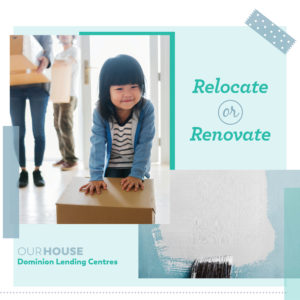 Relocate or Renovate.
Relocate or Renovate.
Like Lighting in a Bottle. That’s how Todd Talbot describes the chemistry between him and Jillian Harris, his co-host of the reality TV series Love It or List It Vancouver. There’s an undeniable electricity that flows between the pair who have battled against each other through 104 hour-long episodes of the home-design series. Sparks fly, but ultimately, both have the same goal: to find a solution for homeowners whose spaces simply don’t suit their needs.
In the “love it” corner is Harris, an interior designer (she wore her heart on her sleeve on The Bachelor and The Bachelorette) whose strategy is to help homeowners kiss and make up with their space, thanks to her design-savvy renovation. Talbot, a realtor (he’s been acting on stage and screen since he was a kid), is firmly in the “list it” corner, coaching quarrelsome couples to sell and start fresh.
The sparring is real, but there’s no bad blood between Harris and Talbot. “Jill and I really agree with each other 99 per cent of the time,” says Talbot. “We’re like brother and sister with each other, on camera and off.”
EMBRACING CHANGE
Buy or renovate? Talbot says the answer isn’t absolute. “Generally speaking [buying a house]; it’s a really fun journey. And it can be really fun on the reno side,” he says. “Life is lived in the grey areas, the nuances in between.” Those shades of grey involve negotiation and prioritization, among other practical and philosophical considerations that happen behind the scenes.
Off set, Talbot is a dedicated DIYer. “My happy place is building and renovating. I manage all my rental properties and do almost all the maintenance,” he says. He even renovated the house he shares with his wife and two children, located in Lions Bay, a sleepy seaside town in B.C. But that doesn’t mean they’ll live there forever. Like the homeowners featured on the show, Talbot and his wife wrestle with opposing forces. “Are we going to sell? Stay? Move?” Relocation to a condo in the city is a real consideration.
That struggle is what makes the show’s appeal universal. Our lives are constantly shifting. Babies are born and kids move out. Jobs change and communities evolve. Still, many homeowners are reluctant to step outside of their comfort zones, says Talbot, noting that the people who come on the show are fixated on location. “I’m the opposite: I’m a change guy. I love the idea of a different home in a different area. Nothing excites me more.”
As the TV series closes in on its fifth year of filming in June, Harris, a new mom, reflects on how her design sensibilities have shifted. “Now that I’m a parent, especially, I’m leaning towards more colour, less clutter and softer finishes, whereas before I was all about everything being white,” she says.
No two families are alike, but all are in desperate need of change, says Harris. She eases the transition, giving growing families more functional space within the existing square footage or cozying up a family home that feels empty after the kids have moved out. Each has their own wants, needs and personal style, which Harris tries to tease out of the homeowners so she can design workable spaces they love. “It’s our job to show them their best options and help guide them towards the right choice for them,” says Harris.
The obstacles families face, however, go beyond bad design and unpredictable real estate markets. A recent episode of Love It or List It Vancouver, where the homeowner uses a wheelchair, presented a new type of design challenge for Harris. “I wanted to think about every part of her home she would experience, from the front entrance to the kitchen cabinetry to being in the living room with her family. Even though they ultimately chose to list [the house], that episode really stuck with me and reminds me not to take things for granted.”
FINANCING FIRST
Whether overhauling an aging home with a sinking foundation, or buying bigger in a hot real estate market, those decisions are guided by budget. “People don’t want to talk about money. It’s not sexy,” says Talbot. His true passion for real estate is connected with the financial side. “What I really love doing is empowering people and coaching them to be able to make the decision to fulfil their vision.”
Talbot believes that gathering information and building knowledge is essential, rather than solely relying on an expert’s perspective. When you start making decisions based on instinct, it takes lots of the worry out of homeownership. He also believes everyone should view real estate as an investment and determine the end game of the property before they buy it: when they’re going to sell it and who they’re going to sell it to.
“At the end of the day, for anyone making decisions about renos or buying and selling, that’s a very personal choice and a choice that ultimately the homeowner takes responsibility for,” says Talbot.
Harris also advises thinking long-term. “It’s so important to look at both your five and 10-year plan as a family. If your house does not have any additional square footage to work with, then maybe a lipstick reno and a quick sell is your best option,” she says. “If your home does have extra space [and] it’s just not being utilized well, but you love the neighbourhood, then I would suggest renovating it to support your family for years to come.”
HOMEOWNERSHIP FOR ALL
For his part, Talbot is rethinking the entire ethos of homeownership. “In today’s day and age, we don’t live the same way as our grandparents did, [who] lived in their houses for 50 years. [Now] houses are more designed to facilitate lifestyle than be the lifestyle themselves,” he says.
“I’m really interested in the idea of redefining the Canadian dream of what makes a great house.” I think we’ve gotten off target as a society: 5,000 square feet is indulgent!” Instead, Talbot says it’s about those shades of grey and finding the sweet spot where financial responsibility, sustainability and quality of life intersect.
That’s a tough sell for some. Especially when our social media feeds are awash with idyllic images of families frolicking in sprawling backyards and cooking in couture kitchens. Dream home envy indeed. Harris sees beyond the soft filters and careful cropping and suggests homeowners look inward.
“I think the best thing is to identify what’s important to you and then build a plan around how to achieve that,” she says. “Or, be on Love It or List It Vancouver and have Todd and I figure it all out for you!”
TODD’S FIRST MORTGAGE
“Real estate kind of snuck up on me. I didn’t get into it for the money,” says Talbot who was working as successful actor when he started renovating.
“I’ve always struggled with this: being an artist and this financial fixation.” Talbot describes his first foray into the real estate market. “I bought a two-bedroom, two bathroom condo in [the Kitsilano neighbourhood in Vancouver], which happened to be the display suite. I had no furniture so I tried to negotiate in all the staging furniture.
They didn’t go for it. The only way I could swing buying my first place was to convince my buddy to rent the other room from me and that ended up subsidizing half my monthly costs. I drew up what I would later learn was a rental contract, literally on the back of a napkin. We lived together for three years before that property turned into a rental property. I refinanced it many times and funded multiple other properties with it.
I learned huge lessons owning that first property, which I sold a few years ago.”
JILLIAN’S DESIGN SECRETS
Harris is expanding her airy aesthetic of white-on-white and introducing saturated splashes of colour. Here, she shares five tips on finding your own style. Mix it up “I like to mix vintage with all sorts of eclectic styles. I like a tad of whimsy in a space and I love to see a person’s personality and life experiences shine through in the décor.” Harris also likes blending textures: “I love mixing muslins with thick rugs and knits and sequins and sparkles.”
Build Layers: Start with a blank canvas and build layers within the room. Anchor a room with an area rug, then add larger investment pieces such as sofas and loveseats. Then add in smaller pieces such as side chairs, ottomans and table lamps.
Get Colorful: “I have had a lot of fun over the years experimenting with coloured kitchens, using finishes like olive green and royal blue.”
Add Artwork: Harris suggests finding something inexpensive yet valuable in a sentimental way to inject polish and personality into your home. Or making a piece from meaningful items. “Frame flies from your great grandpa’s fly-fishing collection.”
Accessorize: Achieve a luxe look for less with a high-low mix of accessories, such as “steals” from stores such as Home- Sense and Target and “splurges” from boutiques, which act as “the icing” on the cake. “It gives your house that look of timelessness and richness.”
Published by DLC Marketing Team

 First Time Home Buyer
First Time Home Buyer